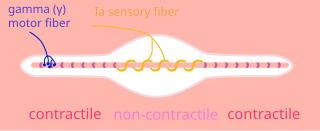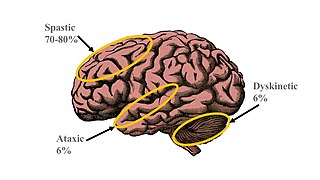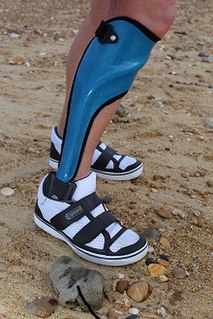Related Research Articles
Hemiparesis, or unilateral paresis, is weakness of one entire side of the body. Hemiplegia is, in its most severe form, complete paralysis of half of the body. Hemiparesis and hemiplegia can be caused by different medical conditions, including congenital causes, trauma, tumors, or stroke.
Spasticity is a feature of altered skeletal muscle performance with a combination of paralysis, increased tendon reflex activity, and hypertonia. It is also colloquially referred to as an unusual "tightness", stiffness, or "pull" of muscles.
Tetraplegia, also known as quadriplegia, is paralysis caused by illness or injury that results in the partial or total loss of use of all four limbs and torso; paraplegia is similar but does not affect the arms. The loss is usually sensory and motor, which means that both sensation and control are lost. The paralysis may be flaccid or spastic.
Clonus is a set of involuntary and rhythmic muscular contractions and relaxations. Clonus is a sign of certain neurological conditions, particularly associated with upper motor neuron lesions involving descending motor pathways, and in many cases is, accompanied by spasticity. Unlike small, spontaneous twitches known as fasciculations, clonus causes large motions that are usually initiated by a reflex. Studies have shown clonus beat frequency to range from three to eight Hz on average, and may last a few seconds to several minutes depending on the patient’s condition. The term is from the Greek for "violent, confused motion"
In physiology, medicine, and anatomy, muscle tone is the continuous and passive partial contraction of the muscles, or the muscle's resistance to passive stretch during resting state. It helps to maintain posture and declines during REM sleep.

A gamma motor neuron, also called gamma motoneuron, or fusimotor neuron, is a type of lower motor neuron that takes part in the process of muscle contraction, and represents about 30% of (Aγ) fibers going to the muscle. Like alpha motor neurons, their cell bodies are located in the anterior grey column of the spinal cord. They receive input from the reticular formation of the pons in the brainstem. Their axons are smaller than those of the alpha motor neurons, with a diameter of only 5 μm. Unlike the alpha motor neurons, gamma motor neurons do not directly adjust the lengthening or shortening of muscles. However, their role is important in keeping muscle spindles taut, thereby allowing the continued firing of alpha neurons, leading to muscle contraction. These neurons also play a role in adjusting the sensitivity of muscle spindles.
Range of motion (ROM) is when a person has become injured in some way, most times the doctor's advice the patients to exercise and stretch the back muscles. For this purpose a form of exercises called range of motion exercises which are used to keep the muscles and joints in the patients back strong and flexible. These exercises can be done by the patient himself, or with a physical therapist. If these exercises are done alone they would be called active range of motion (AROM) exercises and if they require assistance they would be called active-assisted range of motion (AAROM) exercises.
Range of motion, is the linear or angular distance that a moving object may normally travel while properly attached to another. It is also called range of travel, particularly when talking about mechanical devices and in mechanical engineering fields. For example, a sound volume control knob.
Hypertonia is a term sometimes used synonymously with spasticity and rigidity in the literature surrounding damage to the central nervous system, namely upper motor neuron lesions. Impaired ability of damaged motor neurons to regulate descending pathways gives rise to disordered spinal reflexes, increased excitability of muscle spindles, and decreased synaptic inhibition. These consequences result in abnormally increased muscle tone of symptomatic muscles. Some authors suggest that the current definition for spasticity, the velocity-dependent over-activity of the stretch reflex, is not sufficient as it fails to take into account patients exhibiting increased muscle tone in the absence of stretch reflex over-activity. They instead suggest that "reversible hypertonia" is more appropriate and represents a treatable condition that is responsive to various therapy modalities like drug and/or physical therapy.

Spastic diplegia is a form of cerebral palsy (CP) that is a chronic neuromuscular condition of hypertonia and spasticity—manifested as an especially high and constant "tightness" or "stiffness"—in the muscles of the lower extremities of the human body, usually those of the legs, hips and pelvis. Doctor William John Little's first recorded encounter with cerebral palsy is reported to have been among children who displayed signs of spastic diplegia.

Paratonia is the inability to relax muscles during muscle tone assessment. There are two types of paratonia: oppositional and facilitatory. Oppositional paratonia ("gegenhalten") occurs when subjects involuntarily resist to passive movements, while facilitatory paratonia ("mitgehen") occurs when subjects involuntary assist passive movements.
Clasp-knife response refers to a Golgi tendon reflex with a rapid decrease in resistance when attempting to flex a joint, usually during a neurological examination. It is one of the characteristic responses of an upper motor neuron lesion. It gets its name from the resemblance between the motion of the limb and the sudden closing of a claspknife after sufficient pressure is applied.
The Ballard Maturational Assessment, Ballard Score, or Ballard Scale is a commonly used technique of gestational age assessment. It was devised by Dr Jeanne L Ballard, Professor Emeritus of Pediatrics, Obstetrics and Gynecology at the University of Cincinnati College of Medicine.

Muscle contractures can occur for many reasons, such as paralysis, muscular atrophy, and forms of muscular dystrophy. Fundamentally, the muscle and its tendons shorten, resulting in reduced flexibility. For example, in the case of partial paralysis the loss of strength and muscle control tend to be greater in some muscles than in others, leading to an imbalance between the various muscle groups around specific joints. Case in point: when the muscles which dorsiflex are less functional than the muscles which plantarflex a contracture occurs, giving the foot a progressively downward angle and loss of flexibility. Various interventions can slow, stop, or even reverse muscle contractures, ranging from physical therapy to surgery. A common cause for having the ankle lose its flexibility in this manner is from having sheets tucked in at the foot of the bed when sleeping. The weight of the sheets keep the feet plantarflexed all night. Correcting this by not tucking the sheets in at the foot of the bed, or by sleeping with the feet hanging off the bed when in the prone position, is part of correcting this imbalance.

Orthotics is a medical specialty that focuses on the design and application of orthoses. An orthosis is "an externally applied device used to influence the structural and functional characteristics of the neuromuscular and skeletal system".

Dynasplint Systems, Incorporated (DSI) is a company that designs, manufactures and sells dynamic splints that are used for range of motion rehabilitation. The corporate headquarters are located in Severna Park, Maryland and it is considered a major employer in Anne Arundel County. Products are Made in the USA in Stevensville, Maryland. There is a national sales force throughout the US as well as a presence in Canada and Europe.
Upper-limb surgery in tetraplegia includes a number of surgical interventions that can help improve the quality of life of a patient with tetraplegia.
Upper motor neuron syndrome (UMNS) is the motor control changes that can occur in skeletal muscle after an upper motor neuron lesion.
Electrophysiological techniques for clinical diagnosis will discuss the techniques borrowed from electrophysiology used in the clinical diagnosis of subjects. There are many processes that occur in the body which produce electrical signals that can be detected. Depending on the location and the source of these signals, distinct methods and techniques have been developed to properly target them.
In medicine, obligatory synergies occur when spasticity appears, such as following a stroke. It manifests in abnormal and stereotypical patterns across multiple joints called obligatory synergies. They are described as either a flexion synergy or an extension synergy and affect both the upper and lower extremity. When these patterns occur in a patient, he or she is unable to move a limb segment in isolation of the pattern. This interferes with normal activities of daily living. Some aspects of the obligatory synergy patterns however, can be cleverly used to increase function relative to the movement available to the individual. Careful thought should, therefore, be considered in deciding which muscle groups to stretch at specific times during recovery. Obligatory synergy patterns are observed when a patient tries to make a minimal voluntary movement, or as a result of stimulated reflexes.
References
- ↑ Ansari, NN; Naghdi, S; Arab, TK; Jalaie, S (2008). "The interrater and intrarater reliability of the Modified Ashworth Scale in the assessment of muscle spasticity: limb and muscle group effect". NeuroRehabilitation. 23 (3): 231–7. doi:10.3233/NRE-2008-23304. PMID 18560139.
- 2 Bohannon RW and Smith MB; 1987:Physical Therapy, 67(2), 206–207